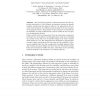Free Online Productivity Tools
i2Speak
i2Symbol
i2OCR
iTex2Img
iWeb2Print
iWeb2Shot
i2Type
iPdf2Split
iPdf2Merge
i2Bopomofo
i2Arabic
i2Style
i2Image
i2PDF
iLatex2Rtf
Sci2ools
EUROS
2008
2008
Eyes-Neck Coordination Using Chaos
Abstract. The increasing complexity of humanoid robots and their expected performance in real dynamic environments demand an equally complex, autonomous and dynamic solution. Our approach for the creation of real autonomy in artificial systems is based on the use of nonlinear dynamical systems. The purpose of this research is to demonstrate the feasibility of using coupled chaotic systems within the area of cognitive developmental robotics. Using a robotic head, we demonstrate that the visual input coming into the head's eyes is enough for the self-organization of the axes controlling the motion of eyes and neck. No specific coding of the task is needed, which results in a very fast adaptation and robustness to perturbations. Another equally important goal of this research is the possibility of having new insights about how the coordination of multiple degrees of freedom emerges in human infants. We show that the interaction between body and environment modifies the inner connecti...
Cognitive Developmental Robotics | EUROS 2008 | Nonlinear Dynamical Systems | Real Dynamic Environments | Robotics |
Related Content
| Added | 19 Oct 2010 |
| Updated | 19 Oct 2010 |
| Type | Conference |
| Year | 2008 |
| Where | EUROS |
| Authors | Boris Duran, Yasuo Kuniyoshi, Giulio Sandini |
Comments (0)

